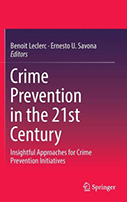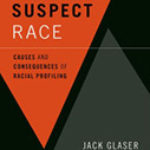Crime Prevention In The 21st Century: Insightful Approaches For Crime Prevention Initiatives

Editors: Benoit Leclerc and Ernesto
Publisher: New York: Springer, 2016. 396p.
Reviewer: Gloria Laycock | July 2017
As is now well documented, volume crime (theft, house burglary, car crime) rose steadily throughout the latter half of the 20th Century and then began to drop steadily from the early 1990s in most advanced Western democracies. The reasons for the decline are poorly understood, but include speculation about abortion, lead in petrol, situational changes, drug consumption patterns etc. These possibilities and others are reviewed by Farrell (2013), who concludes that the most parsimonious explanation is probably due to target hardening and other situational initiatives.
The editors of this book begin by acknowledging the crime drop but go on to suggest that crime has changed considerably as we move into the 21st Century. They focus on terrorism as an example of a growth area which, they say, has been poorly served by prevention to date. I think they are missing a trick in taking this line as justification for a book on crime prevention in the 21st Century. First, terrorism is not new; and secondly, terrorist offences are often prevented. In the UK at least, the counter terrorist authorities (police, National Crime Agency, GCHQ, and the secret services) do interrupt terrorists in the course of their activities. One outgoing Commissioner of Police in London, for example, referred to at least seven attempts at atrocities in the Capital which were prevented during his tenure. These operations rely heavily on intelligence and surveillance and they are not fool-proof by any means – but they can be effective. So, hanging the case for a fresh approach to prevention on the terrorist threat rather misses the far more obvious and ubiquitous growth in cyber-crime. Here we have a whole category of offences that have mushroomed in the early part of the 21st Century with very little information on the nature of the crimes, their perpetrators, or what can be done to reduce them. By way of example, for the first time in 2016 the Crime Survey of England and Wales attempted to estimate the extent of cyber-crime through the crime survey and concluded that there had been over 5 million offences over the 12-month period – effectively doubling the estimated crime rate. It is perhaps surprising, therefore, that there is nothing in this book specifically about cyber-crime or other emerging threats until we get to the very last chapter.
Rather than taking specific offences, the book focuses on approaches to research, which the editors argue provide fertile ground for the growth of crime prevention activities – a much needed strategy given the difficulty in catching offenders. It is well structured – following a general introductory chapter there are seven sections, each opening with a chapter outlining a technique or approach followed by between two to four further chapters by different authors illustrating the technique in practice, sometimes related to a specific crime and sometimes to a class of offenders. The introductory descriptions of these techniques are written by experts in the approach, which is helpful to those unfamiliar with what is covered and how it has developed.
I was expecting to find that each section offered a new research approach, so it was a surprise to see that the first section was about the offenders’ perspective on crime prevention and involved interviewing known offenders to discuss how they carry out their offences and what might have prevented them. This is hardly a novel approach, but was described by clear enthusiasts who (grudgingly?) mentioned a few possible draw backs to offender interviews in the penultimate paragraph. That said, the first example, looking at what can be learned from aborted crimes – specifically robbery (including home robberies which in some jurisdictions would be called burglary) – was both interesting and informative. For example, home robberies were more likely to be aborted than commercial or street robberies and, perhaps surprisingly, robberies that were planned for more than an hour were more likely to be abandoned than those planned for less than an hour. Similarly, the following chapter, by Martin Gill, was well structured and offered useful insights into possible iatrogenic effects of crime prevention; an area where more research is needed.
The next topic was crime script analysis – hardly a surprising choice given that one of the book’s editors is Benoit Leclerc, a fan of the approach and author of the introductory chapter. Crime scripts have become increasingly popular as a research tool in recent years, and as the two following chapters illustrate, have produced a useful perspective on crime. The chapter by Marti Smith (whose husband Derek Cornish wrote the seminal article on crime scripts) described interviews with taxi drivers who had been the victims of robbery. She nicely pulls out the lessons for crime prevention and provides a critical assessment of some current approaches in the light of the interview data.
The following section on crime mapping and spatial analysis departed from the book’s structure in that the first chapter on crime mapping thoroughly described the approach and the second chapter did the same again, albeit with some examples showing crime maps. Rather better was the section which followed, on social network analysis (SNA), which reverted to presenting a good first chapter describing SNA and followed this with three examples of it in use, all of which provided valuable insights into some difficult crime problems. The first looked at methamphetamine manufacture and trafficking, and showed how the organised crime groups developed over time, pointing to the opportunities offered for crime prevention by a careful and highly structured analysis of the data. It would have been good to have heard that these ideas were going to be implemented and followed up – but perhaps that is for a later volume. The second ‘applied’ chapter looked at uncovering the social pecking order in gang violence. For me this was one of the highlights of the book. The authors (Randle and Bischler) begin their chapter by quoting from Papachristos (209:75) who says:
Gang members do not kill because they are poor, black, or young or live in socially disadvantaged neighbourhoods. They kill because they live in a structured set of social relations in which violence works its way through a series of connected individuals.
If true, this points to the importance of understanding the social structure and the dynamics of social groups and to studying them over time. Randle and Bischler showed the potential of the approach using data collected on Californian gangs over a 9-year period, and tested the effect of court injunctions on later violence. They provided recommendations for the courts in relation to injunctions which, they suggest, would lead to improved crime prevention outcomes. The final chapter in this section was particularly remarkable in drawing on data provided by the Spanish Guardia Civil, which gave detailed access to the investigation of a cocaine drug trafficking group in Spain over a 3-year period. Anyone who works with police data will know how difficult it can be to obtain – so hats off to this research team for managing to get such valuable data sets and to then provide an enlightening analysis. This chapter provides an excellent example of what can be produced with the right data and thoughtful handling. We need more like it.
The next section is on agent based modelling (of which I should confess to being a great fan!). Dan Birks does a good job of explaining the approach and describing its uses in addressing crime problems: it can assist in testing theories and importantly can predict what might happen were a policy to be implemented, when to do so in the real world might lead to all sorts of ethical or practical difficulties. The ‘applied’ chapter is by Gerritsen and Elffers, who nicely illustrate its use.
Ernesto Savona, the second editor of the volume, introduced the next section on crime-proofing legislation. This is an area in which Savona has great expertise and he provides some helpful checklists and useful examples of the process. Stefano Caneppele gives a detailed example of attempts to improve the legislation in the EU in relation to tobacco products. It transpired as a sorry tale of missed opportunity and poor implementation – not unfamiliar to those with crime prevention aspirations. The second case study is provided by Masters and Graycar who provide some fascinating long-term data on sex work in the State of Victoria, Australia. They describe the process and consequences of the decriminalisation of sex work in the State. Their last sentence says it all: ‘It cannot be said that decriminalisation has prevented crime in the sex industry, but in this instance it has replaced one set of Victorian values with a new set of values for Victoria’ (p.307).
The final section was in a somewhat different category in not describing a research approach so much as a potential response to 21st Century crime. It focussed on technology and its possible application in reducing the new types of crime that we might be faced with in future. The introductory chapter was written by Paul Ekblom, and was so rich in ideas it gave me a headache! He attempts to place technology in a larger framework of preventive approaches, which although valuable is not too well connected to the following two chapters – the first of which describes some of the technicalities and perceptual issues in preventing crimes associated with the emergence of drones. It is a chapter for the technological enthusiast with an interest in how passive radar technology can transform surveillance opportunities. Although not mentioned by the authors, it also provides an example of the kind of development to which lawyers and civil rights experts will want to turn their attention as we move further into the 21st Century.
The final chapter by Farrell and Tilley shows how technological developments can affect crime, specifically by increasing the supply of criminal opportunities. By using the drops in car crime as an example they argue the need for the development of well designed, ‘elegant’ solutions in the future.
This is a substantial publication at almost 400 pages, and has been nicely produced by the publisher. In any volume of this size there are some winning chapters and some losers. In this case, it is fair to say that the majority are winners in my view, although there were a couple of chapters that could have been dropped and at least two that needed some serious editing. The highlights? Probably the basic notion that in the 21st Century we need a rethink our approach to crime control bearing in mind the turbulent times in which we live. The book also provided some exciting illustrations of how the various techniques might further the cause of crime prevention. The task now is to implement and evaluate more of these potentially fruitful approaches and to contribute to what we know might work, where and how.
Gloria Laycock. Professor of Crime Science, UCL
References
Farrell, G. (2013) ‘Five tests for a theory of the crime drop,’ Crime Science: An Interdisciplinary Journal 20132:5 DOI: 10.1186/2193-7680-2-5


